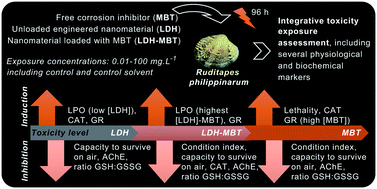Effects of a novel anticorrosion engineered nanomaterial on the bivalve Ruditapes philippinarum†
Abstract
Metallic corrosion is an unsolved problem that has been minimized through the application of specialized coatings containing corrosion inhibitors, such as 2-mercaptobenzothiazole (MBT). Recently, engineered nanomaterials (ENM), such as layered double hydroxides (LDH), have been used to immobilize or encapsulate those compounds promoting their controlled release in a more eco-friendly way. The present study aims to assess the toxicity of a novel anticorrosion nano-based solution (LDH loaded with MBT) and its major compounds separately (MBT and LDH) to the clam Ruditapes philippinarum, during a short-term exposure (96 h). The endpoints were lethality and changes in the physiological and biochemical parameters. MBT induced mortality (LC20 = 78.14 mg L−1) and significant physiological and biochemical changes. Globally, these effects were more severe than those treated with LDH and LDH–MBT that still induced significant biochemical effects. The present study demonstrated the eco-friendly properties of the immobilization process of the corrosion inhibitor in the nanoclays. Effects were observed at higher concentrations than those expected to occur in the environment and therefore these novel nanomaterials can be a promising anticorrosion material with low environmental hazard and risk.



 Please wait while we load your content...
Please wait while we load your content...